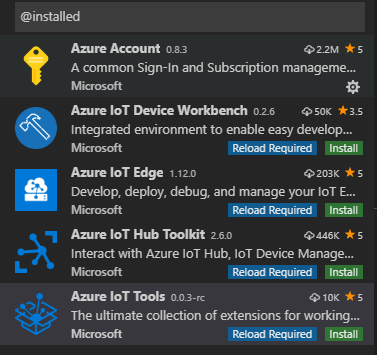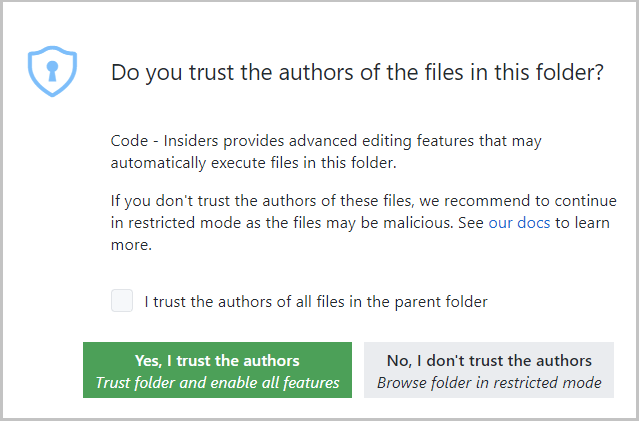The 'Azure IoT Tools' collection is being retired after November 2022, and contains three extension packages that can still be downloaded individually:
- Azure IoT Hub Toolkit
- Azure IoT Edge
- Azure IoT Workbench (support ending, older versions can still be downloaded from the github releases page for the extension)
The repository has been archived and is read-only. Currently installed extensions will not be affected, but no new versions will be made available in the marketplace.
Furthermore, after November 2022 users will no longer be able to install this extension collection from the marketplace.
Microsoft Azure IoT support for Visual Studio Code is provided through a rich set of extensions that make it easy to discover and interact with Azure IoT Hub that power your IoT Edge and device applications.
If you do not have an Azure subscription, sign up today for a free account. You'll get 12 months of popular free services, $200 in Azure Credits to try out any combination of Azure services, and access to free services such as Azure IoT Hub, Azure IoT Edge, etc.
- Update infrastructure to support localization (Thanks @matsujirushi!)
- Localization for Japanese language (Thanks @matsujirushi!)
- Expose API to read IoT Hub connection string
- Use OS credential store to store IoT Hub connection string (To be more secure, we will no longer use
azure-iot-toolkit.iotHubConnectionStringin settings.json to store IoT Hub connection string)
- ASA error message improvement
- Rename 'tempSensor' to 'SimulatedTemperatureSensor'
- Read connection string from API of Azure IoT Hub Toolkit
- We are excited to announce the preview of a new feature enabled in Azure IoT Device Workbench extension in VS Code to simplify the device cross-compiling toolchain acquisition effort for device developers working on embedded Linux devices (e.g. Debian, Ubuntu, Yocto Linux…) with Azure IoT by encapsulating the compilers, device SDK and essential libraries in Containers. All you need is to install or upgrade the IoT Device Workbench and get started developing within the container, just like today you are using a local environment.
- Fix the issue of "MXCHIP AZ3166 serial port button not work" #661 which started after update to VS Code 1.36.0.
Special thanks to br1pro and Remco Ploeg, thanks for your feedbacks.
-
Develop and connect your Azure IoT Applications to Azure using the Azure IoT Toolkit. With this extension, you can interact with an Azure IoT Hub, manage connected devices, and enable distributed tracing for your Azure IoT applications.
-
Develop and debug Certifies Azure IoT Devices (including MXChip IoT DevKit, ESP32, Raspberry Pi) to Azure using the Azure IoT Device Workbench. The IoT Device Workbench extension makes it easy to code, build, deploy and debug your IoT applications with popular IoT development boards.
-
Develop and deploy artificial intelligence and your custom logic to Azure IoT Edge with Azure IoT Edge for VS Code. Azure IoT Edge extension makes it easy to code, build, deploy, and debug your IoT Edge applications.
By installing this extension you will install all of the extensions listed above. Some of these extensions will have a dependency on the Azure Account extension to provide a single Azure login and subscription filtering experience.
You can easily uninstall individual extensions if you are not interested in using them, without affecting other extensions provided by this pack. You can uninstall all of the extensions by uninstalling the Azure Tools extension.
After successfully installing this extension, you can follow the steps below to setup your IoT Hub. you can use IoT Hub connection string or sign in to Azure to select IoT Hub:
You can use IoT Hub connection string to setup your IoT Hub
-
In Explorer of VS Code, click "Azure IoT Hub Devices" in the bottom left corner.
-
Click "Set IoT Hub Connection String" in context menu.
-
An input box will pop up, then enter your IoT Hub Connection String (It is one-time configuration, and please make sure it is IoT Hub Connection String and not Device Connection String. The format is
HostName=<my-hub>.azure-devices.net;SharedAccessKeyName=<my-policy>;SharedAccessKey=<my-policy-key>). -
The device list will be shown.
-
Then you can manage your devices and interact with Azure IoT Hub through context menu.
NOTE: You can also go to File > Preferences > Settings (Code > Preferences > Settings), and update the configuration of
azure-iot-toolkit.iotHubConnectionStringto change your IoT Hub Connection String.
Instead of copying and pasting to set IoT Hub Connection String, you can sign in to Azure and select IoT Hub from your Azure Subscription.
-
In Explorer of VS Code, click "Azure IoT Hub Devices" in the bottom left corner.
-
Click "Select IoT Hub" in context menu.
-
If you have not signed in to Azure, a pop-up will show to let you sign in to Azure.
-
After signing in, your Azure Subscription list will be shown, then select an Azure Subscription.
-
Your IoT Hub list will be shown, then select an IoT Hub.
-
The device list will be shown.
You can access almost all Azure IoT Services provided by these extensions through the Command Palette. Simply press F1, then type in IoT to find available commands.
Got a suggestion for the Azure IoT Tools extension? Submit a new issue and a PR with an updated package.json and README.md and we'll take a look!
Most contributions require you to agree to a Contributor License Agreement (CLA) declaring that you have the right to, and actually do, grant us the rights to use your contribution. For details, visit https://cla.microsoft.com.
When you submit a pull request, a CLA-bot will automatically determine whether you need to provide a CLA and decorate the PR appropriately (e.g., label, comment). Simply follow the instructions provided by the bot. You will only need to do this once across all repos using our CLA.
This project has adopted the Microsoft Open Source Code of Conduct. For more information see the Code of Conduct FAQ or contact [email protected] with any additional questions or comments.

















